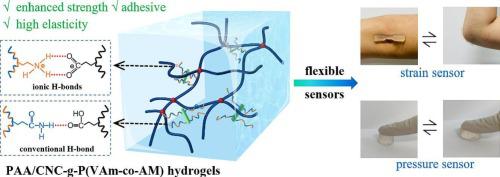Carbohydrate Polymers ( IF 10.7 ) Pub Date : 2023-06-05 , DOI: 10.1016/j.carbpol.2023.121092 Bengang Li 1 , Yurui Chen 1 , Wei Wu 1 , Xuzhi Cao 1 , Zhenyang Luo 1

|
Recently, the application of cellulose nanocrystals (CNCs) in the field of hydrogel sensors has attracted much attention. However, it remains challenging to construct CNC-reinforced conductive hydrogels with a combination of enhanced strength, low hysteresis, high elasticity and remarkable adhesiveness. Herein, we present a facile method to prepare conductive nanocomposite hydrogels with the above-mentioned properties by reinforcing chemically crosslinked poly(acrylic acid) (PAA) hydrogel with rational-designed copolymer-grafted CNCs. The copolymer-grafted CNCs interact with PAA matrix to form carboxyl-amide conventional hydrogen bonds and carboxyl-amino ionic hydrogen bonds, among which the ionic hydrogen bonds with rapid recovery capability are critical to the low hysteresis and high elasticity of hydrogel. The introduction of copolymer-grafted CNCs endowed the hydrogels with enhanced tensile/compressive strength, high resilience (>95 %) during tensile cyclic loading, rapid self-recovery during compressive cyclic loading and improved adhesiveness. Thanks to the high elasticity and durability of hydrogel, the assembled hydrogel sensors exhibited good cycling repeatability and durability in detecting various strains, pressures and human motions. The hydrogel sensors also showed satisfying sensitivity. Hence, the proposed preparation method and the obtained CNC-reinforced conductive hydrogels would open new avenues in flexible strain and pressure sensors for human motion detection and beyond.
中文翻译:

共聚物接枝纤维素纳米晶诱导的纳米复合水凝胶具有增强的强度、高弹性和粘合性,适用于柔性应变和压力传感器
近年来,纤维素纳米晶(CNC)在水凝胶传感器领域的应用备受关注。然而,构建兼具增强强度、低滞后性、高弹性和卓越粘合性的 CNC 增强导电水凝胶仍然具有挑战性。在此,我们提出了一种简便的方法,通过用合理设计的共聚物接枝CNCs增强化学交联聚丙烯酸(PAA)水凝胶来制备具有上述性能的导电纳米复合材料水凝胶。共聚物接枝的CNC与PAA基体相互作用形成羧基-酰胺常规氢键和羧基-氨基离子氢键,其中具有快速恢复能力的离子氢键对于水凝胶的低滞后和高弹性至关重要。共聚物接枝CNC的引入赋予水凝胶增强的拉伸/压缩强度、拉伸循环加载期间的高回弹性(>95%)、压缩循环加载期间的快速自我恢复以及改进的粘合性。由于水凝胶的高弹性和耐用性,组装的水凝胶传感器在检测各种应变、压力和人体运动时表现出良好的循环重复性和耐用性。水凝胶传感器也表现出令人满意的灵敏度。因此,所提出的制备方法和获得的数控增强导电水凝胶将为用于人体运动检测等的柔性应变和压力传感器开辟新途径。在压缩循环加载过程中快速自我恢复并提高粘合性。由于水凝胶的高弹性和耐用性,组装的水凝胶传感器在检测各种应变、压力和人体运动时表现出良好的循环重复性和耐用性。水凝胶传感器也表现出令人满意的灵敏度。因此,所提出的制备方法和获得的数控增强导电水凝胶将为用于人体运动检测等的柔性应变和压力传感器开辟新途径。在压缩循环加载过程中快速自我恢复并提高粘合性。由于水凝胶的高弹性和耐用性,组装的水凝胶传感器在检测各种应变、压力和人体运动时表现出良好的循环重复性和耐用性。水凝胶传感器也表现出令人满意的灵敏度。因此,所提出的制备方法和获得的数控增强导电水凝胶将为用于人体运动检测等的柔性应变和压力传感器开辟新途径。





















































 京公网安备 11010802027423号
京公网安备 11010802027423号